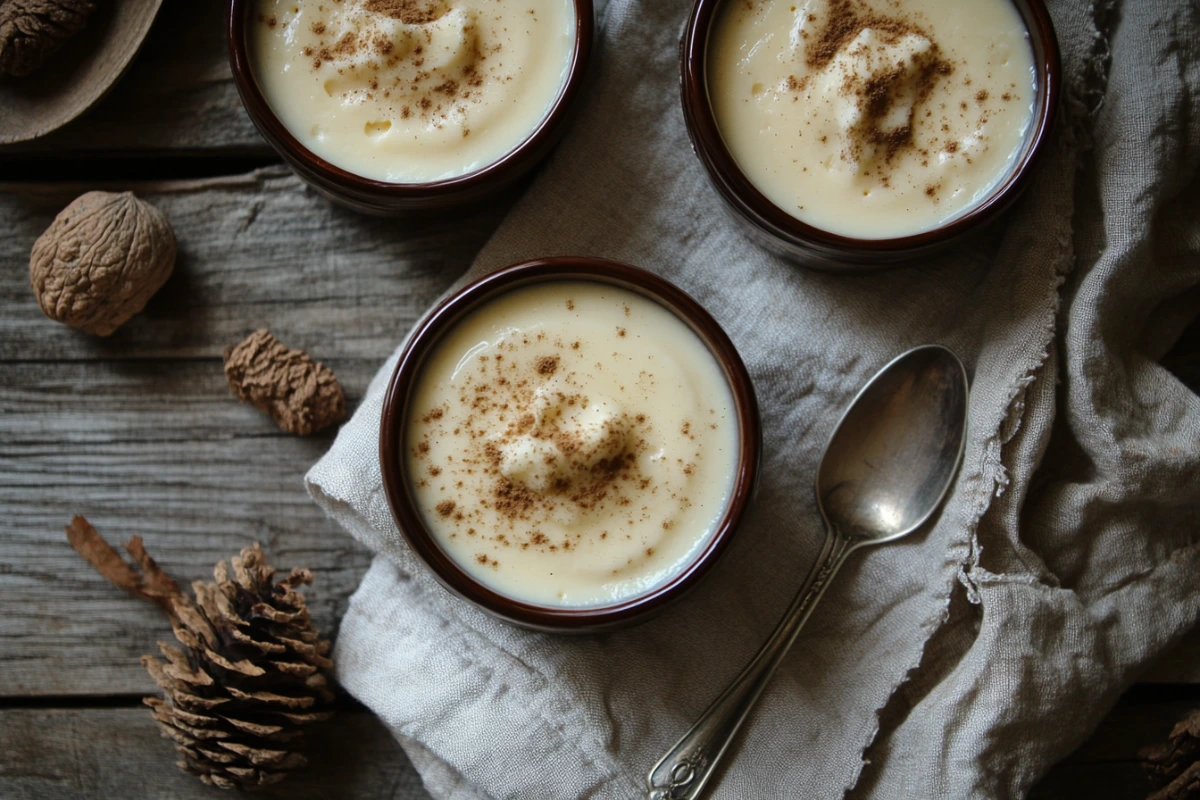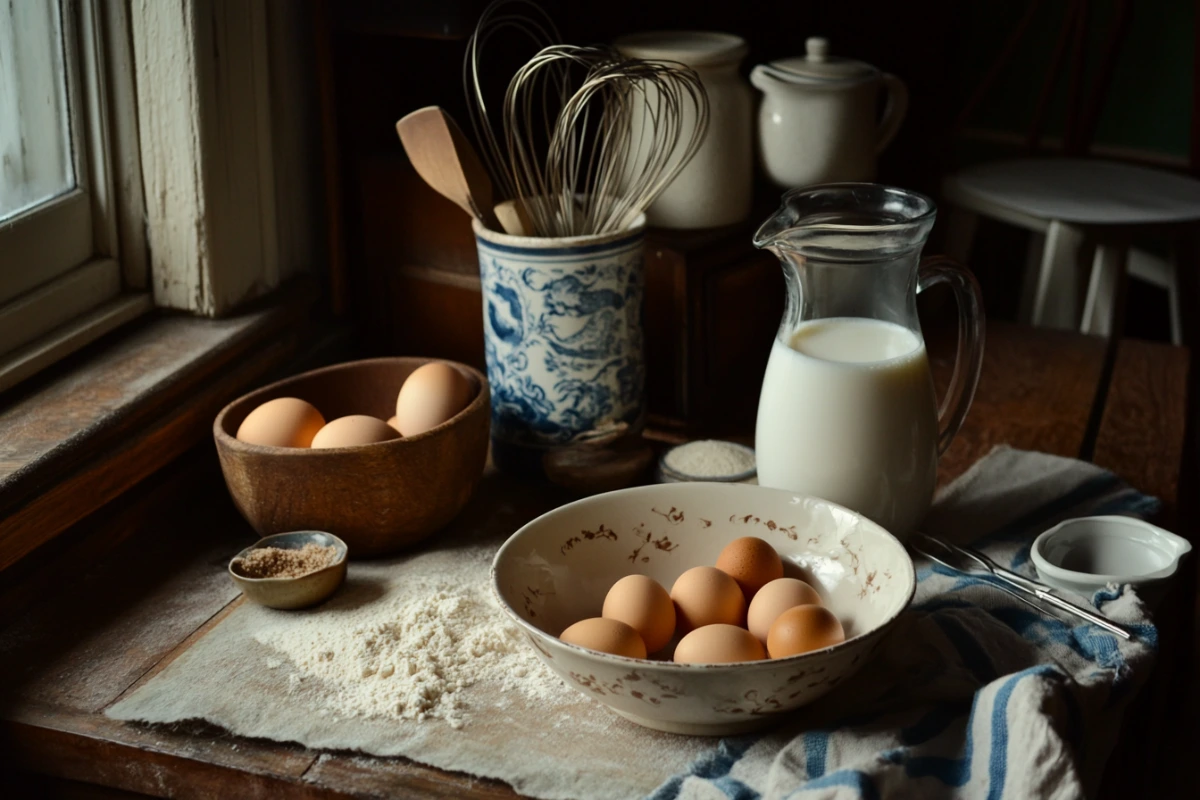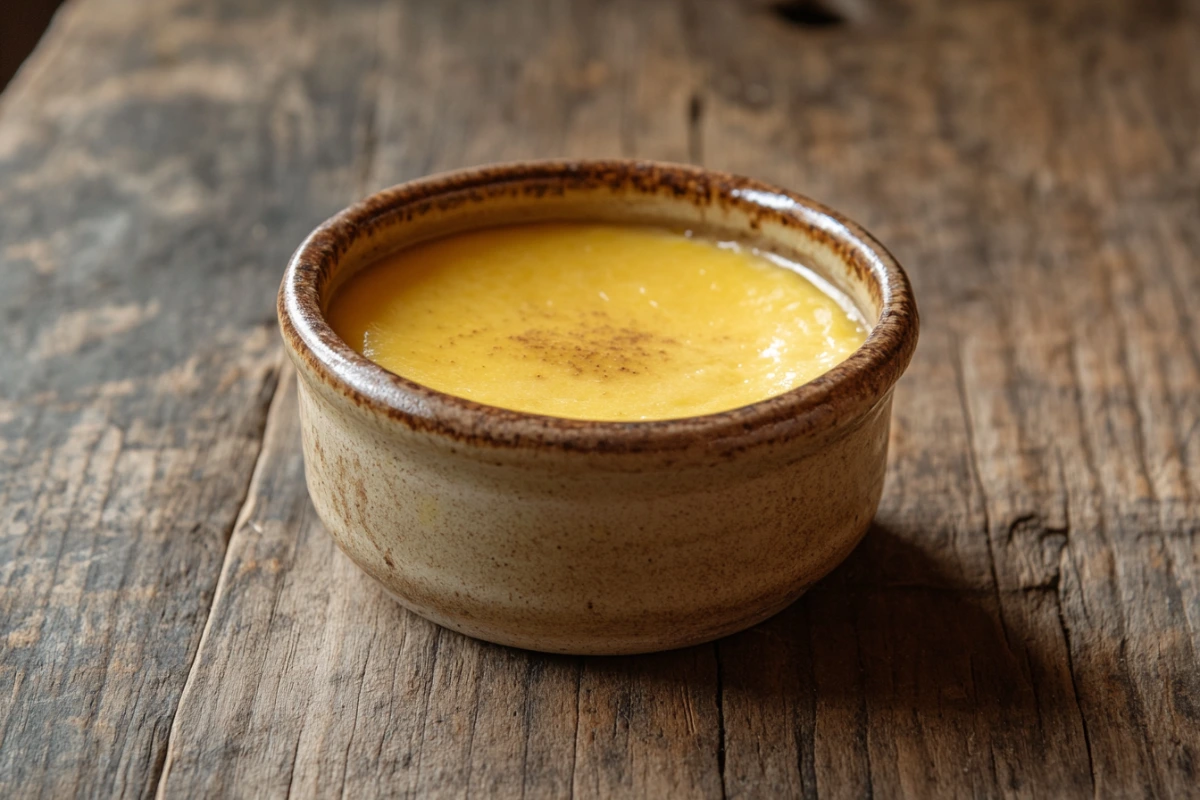Table of Contents
ToggleIntroduction to Amish Baked Custard
What is Amish Baked Custard?
Amish baked custard is a classic dessert steeped in simplicity and wholesome ingredients, embodying the essence of Amish culinary traditions. This creamy delight is crafted from a blend of milk, eggs, sugar, and vanilla, slow-baked to perfection until it achieves a silky, custard-like texture. Often topped with a dash of nutmeg, it offers a comforting, lightly sweetened flavor that highlights the quality of its natural components.
Historically, Amish baked custard has been a staple dessert in Amish communities, where frugality and resourcefulness are highly valued. Its preparation reflects a heritage of minimalism, utilizing basic pantry staples readily available in Amish households. The dessert’s unassuming elegance and rich flavor have transcended its cultural roots, making it a favorite for people seeking a taste of authentic Amish cuisine.
The Appeal of Traditional Amish baked custard
Amish desserts, including baked custard, hold a unique charm. Rooted in centuries-old traditions, these recipes emphasize simplicity, natural ingredients, and an unhurried preparation process. The Amish way of life centers on sustainability and connection to the land, which is evident in their culinary creations. Desserts like baked custard showcase the purity of fresh milk, farm-raised eggs, and hand-ground spices, encapsulating the ethos of their way of living.
In today’s fast-paced world, the allure of such desserts lies in their unpretentious nature and nostalgic comfort. They are a reminder of the joys of savoring slow-cooked, homemade dishes made with care and intention. Amish baked custard, with its creamy texture and delicate sweetness, epitomizes the timeless appeal of these cherished culinary traditions.
Ingredients and Equipment Needed for Amish Baked Custard
Essential Ingredients for Amish Baked Custard
Crafting the perfect Amish baked custard begins with a handful of simple, high-quality ingredients. Each component plays a critical role in achieving the creamy texture and subtle flavors that make this dessert so beloved.
- Eggs: The backbone of any custard, eggs provide structure and richness. Use fresh, large eggs for the best results.
- Milk: Whole milk is traditionally preferred for its creaminess and authentic flavor. For a richer custard, some recipes incorporate a mix of whole milk and heavy cream.
- Sugar: Granulated sugar is commonly used to sweeten the custard, but a touch of brown sugar can add depth and a hint of caramel-like warmth.
- Vanilla Extract: This ingredient infuses the custard with a fragrant sweetness, enhancing the overall flavor.
- Ground Nutmeg: A light sprinkle of nutmeg on top adds a warm, aromatic finish that is quintessential to Amish baked custard.
- Salt: Just a pinch helps balance the sweetness and intensifies the natural flavors of the other ingredients.
These ingredients are not only easy to find but also emblematic of the simplicity that defines Amish desserts.
Recommended Equipment
To achieve the creamy consistency and smooth texture of Amish baked custard, it’s essential to have the right tools on hand. Here’s what you’ll need:
- Mixing Bowls: Essential for whisking together your ingredients. Choose a bowl large enough to comfortably hold all the custard components.
- Whisk: A whisk ensures the custard mixture is smooth and free of lumps, leading to a velvety texture.
- Saucepan: For gently warming the milk before combining it with the eggs, which helps prevent curdling.
- Baking Dish or Ramekins: Custard can be baked in a single dish or divided into individual ramekins for portioned servings. The latter adds a touch of elegance to your presentation.
- Fine-Mesh Sieve: Straining the custard mixture removes any stray bits of egg or impurities, ensuring a silky finish.
- Baking Pan for Water Bath: A water bath, or bain-marie, is key to preventing cracks and ensuring even baking. The pan should be deep enough to hold water that comes halfway up the sides of your baking dish or ramekins.
Having these ingredients and tools ready ensures a seamless baking experience, allowing you to focus on creating a dessert that is both traditional and unforgettable. Whether you’re an experienced baker or a novice, these staples set the foundation for an authentic Amish baked custard.
Preparing the Custard Mixture for the Amish baked custard
Creating the custard mixture is the heart of this recipe. It involves a careful blending of ingredients to ensure a smooth, creamy consistency.
- Scalding the Milk: Begin by pouring the whole milk into a saucepan and heating it gently over medium heat until small bubbles form around the edges. This step, known as scalding, enhances the milk’s flavor and helps the custard set properly. Be sure not to let the milk boil.
- Beating the Eggs and Sugar Until Light: In a mixing bowl, whisk together the eggs and sugar until the mixture becomes pale and slightly frothy. This aeration ensures the custard is light yet rich in texture.
- Tempering the Eggs with Hot Milk: Slowly add the scalded milk to the egg mixture while whisking continuously. This gradual process, called tempering, prevents the eggs from curdling by gently raising their temperature.
- Combining All Ingredients Smoothly: Stir in the vanilla extract and a pinch of salt. To achieve a perfectly smooth custard base, strain the mixture through a fine-mesh sieve into a clean bowl or directly into your baking dish or ramekins.
Setting Up the Baking Environment
Proper preparation of your baking setup is essential for an evenly cooked custard.
- Preheating the Oven to 325°F (165°C): A moderate oven temperature allows the custard to bake gently, preventing cracks and maintaining a silky texture.
- Preparing the Water Bath for Even Cooking: Place your baking dish or ramekins in a larger baking pan. Fill the pan with hot water until it reaches halfway up the sides of the dish. The water bath provides consistent, moist heat, ensuring the custard bakes evenly without drying out.
Baking the Custard
Now it’s time to bake your Amish custard to perfection.
- Pouring the Mixture into the Baking Dish or Ramekins: Carefully transfer the custard mixture into your prepared dish or ramekins, leaving a little room at the top to avoid spills.
- Sprinkling Nutmeg on Top: Lightly dust the surface of the custard with ground nutmeg. This step adds a warm, aromatic note that complements the custard’s creamy sweetness.
- Baking Times and How to Check for Doneness: Bake the custard for 45–55 minutes if using a large dish or 30–40 minutes for ramekins. To test for doneness, gently jiggle the dish; the custard should be set around the edges but slightly wobbly in the center. Alternatively, insert a knife into the center—it should come out clean or with a few moist crumbs.
Cooling and Serving Suggestions
Patience is key when cooling and serving Amish baked custard to ensure the best flavor and texture.
- Allowing the Custard to Cool Properly: Remove the baking dish or ramekins from the water bath and place them on a wire rack. Let the custard cool to room temperature before serving or refrigerating.
- Serving Warm vs. Chilled: Amish baked custard is delightful either warm or chilled. For a comforting dessert, serve it slightly warm; for a refreshing treat, chill it for at least two hours in the refrigerator.
- Garnishing Ideas: While the custard is delicious on its own, you can elevate it with simple garnishes. Fresh berries, a dollop of whipped cream, or a drizzle of caramel sauce can add vibrant flavors and an inviting visual appeal.
Following these steps ensures a flawless Amish baked custard every time. The process may be straightforward, but the result is a dessert that carries the warmth of tradition and the joy of a homemade treat.
Variations and Dietary Adaptations for Amish Baked Custard
Flavor Variations
One of the joys of Amish baked custard is its versatility. While the classic version is timeless, experimenting with flavors can add a personal touch or create a new favorite for your family.
- Adding Spices like Cinnamon or Cardamom: For a warm, aromatic variation, consider blending ground cinnamon or cardamom into the custard mixture. These spices complement the nutmeg topping beautifully and add layers of depth to the dessert.
- Incorporating Citrus Zest for a Zesty Twist: Adding a teaspoon of grated lemon or orange zest can brighten the custard with a refreshing tang. This option pairs especially well with a chilled custard served on a warm day.
These simple flavor adjustments preserve the comforting essence of Amish baked custard while introducing a subtle twist to suit different tastes.
Dietary Substitutions
Whether you’re accommodating dietary preferences or restrictions, there are numerous ways to adapt the traditional recipe without compromising on flavor or texture.
- Using Dairy-Free Milk Alternatives:
- Almond Milk: A mild and nutty option that works well in custard, though it may be slightly less creamy than whole milk.
- Coconut Milk: For a richer custard, coconut milk is an excellent choice, adding a subtle tropical flavor.
- Oat Milk: With its natural sweetness and creaminess, oat milk makes a versatile substitute.
Ensure the chosen alternative milk is unsweetened to maintain control over the dessert’s sugar balance.
- Adjusting Sugar Levels or Using Sugar Substitutes:
- For a lower-sugar version, reduce the amount of sugar or opt for alternatives like stevia, erythritol, or monk fruit sweetener.
- Brown sugar or coconut sugar can also replace granulated sugar for a deeper, more caramel-like flavor.
These substitutions make the custard more inclusive without sacrificing its signature smoothness and taste.
Alternative Cooking Methods
While baking is the traditional method for preparing Amish custard, other approaches can offer unique textures or added convenience.
- Preparing Custard on the Stovetop:
- For a stovetop custard, the mixture is gently cooked over low heat while continuously stirring.
- Use a heavy-bottomed saucepan to prevent scorching, and strain the custard once thickened for an extra-smooth finish.
This method skips the water bath and oven, making it a quicker option when time is of the essence.
- Using a Slow Cooker for a Different Texture:
- In a slow cooker, the custard mixture can be poured directly into the basin or divided into small ramekins.
- Cook on low heat for 2–3 hours, checking occasionally for doneness.
- The slow cooking process yields a slightly firmer texture with a wonderfully rich flavor.
Both alternatives offer flexibility, catering to varying kitchen setups and time constraints while still delivering a delightful custard experience.
Exploring these variations and adaptations can make Amish baked custard a versatile dessert that fits a range of preferences. Whether you’re adding bold spices, embracing dairy-free options, or trying innovative cooking techniques, the core elements of this beloved recipe remain comforting and delicious.
Nutritional Information and Health Considerations
Calorie and Macronutrient Breakdown
Below is the approximate nutritional breakdown per serving (1/2 cup) of traditional Amish baked custard. Please note that values may vary depending on the exact ingredients and portion size used.
| Nutrient | Amount per Serving | % Daily Value (Approx.)* |
|---|---|---|
| Calories | 150–200 kcal | 7–10% |
| Protein | 6 g | 12% |
| Total Fat | 7 g | 9% |
| – Saturated Fat | 3–4 g | 15–20% |
| Cholesterol | 140–160 mg | 45–53% |
| Total Carbohydrates | 18 g | 6% |
| – Sugars | 15–16 g | N/A |
| Dietary Fiber | 0 g | 0% |
| Calcium | 120–150 mg | 12–15% |
| Iron | 0.5 mg | 3% |
| Sodium | 50–70 mg | 2–3% |
*Percent Daily Values are based on a 2,000-calorie diet. Your daily values may be higher or lower depending on your caloric needs.
This table highlights the custard’s balanced nutritional profile, with a good source of protein and calcium while being relatively moderate in calories and fat. For those looking to adjust the nutritional content, substitutions such as low-fat milk or sugar alternatives can tailor the recipe to suit dietary preferences.
Health Benefits and Considerations
- Source of Protein and Calcium: The eggs and milk in custard provide high-quality protein essential for muscle repair and overall health. Milk also contributes calcium, vital for strong bones and teeth.
- Considerations for Those Monitoring Sugar Intake: Traditional recipes include sugar, which contributes to the carbohydrate count. For those watching their sugar intake, natural or artificial sweeteners can be used as substitutes without compromising taste.
Serving Suggestions and Pairings
Ideal Occasions for Serving Amish Baked Custard
Amish baked custard is versatile and fits seamlessly into a variety of occasions, including:
- Family Gatherings: Its comforting, nostalgic appeal makes it a hit at reunions and casual dinners.
- Holiday Celebrations: With its warm, spiced flavor, custard is perfect for Thanksgiving, Christmas, or Easter feasts.
Complementary Dishes and Beverages
Pairing Amish baked custard with the right accompaniments elevates the experience:
- Fresh Fruit or Compotes: A serving of mixed berries, stewed apples, or a tangy raspberry compote adds a burst of freshness that contrasts the custard’s creaminess.
- Coffee or Herbal Teas: The dessert pairs wonderfully with bold, black coffee or mild, soothing herbal teas like chamomile or mint, balancing sweetness with bitterness or earthy notes.
Frequently Asked Questions (FAQs)
Can Amish Baked Custard be made ahead of time?
Yes, it can be prepared a day in advance and stored in the refrigerator. This allows the flavors to meld beautifully.
How should I store leftover custard?
Cover leftovers with plastic wrap or transfer them to an airtight container. Store in the refrigerator for up to 3 days.
Can I freeze Amish Baked Custard?
While freezing is not ideal as it may affect texture, it can be done. Thaw in the refrigerator and reheat gently to restore creaminess.
What causes custard to curdle, and how can I prevent it?
Curdling occurs when the custard overheats. To prevent this, bake it gently in a water bath at the recommended temperature and avoid overcooking.
Is it necessary to use a water bath when baking custard?
Yes, a water bath ensures even cooking and prevents the custard from cracking or curdling by maintaining a consistent temperature.
Exploring the Cultural Significance of Amish Baked Custard
Role in Amish Traditions and Celebrations
Amish baked custard is deeply rooted in the community’s culinary heritage. Its simplicity reflects the values of resourcefulness and reliance on fresh, local ingredients. It often graces tables during community gatherings, weddings, and religious holidays, symbolizing hospitality and togetherness.
Comparison to Other Cultural Custard Variations
Amish baked custard shares similarities with other global desserts, such as:
- Flan: A custard with caramel topping, popular in Spanish and Latin American cuisines.
- Crème Brûlée: A French custard topped with a caramelized sugar crust.
- Egg Tarts: A flaky pastry filled with creamy custard, common in Chinese and Portuguese baking.
These comparisons highlight the universal appeal of custard while showcasing the Amish version’s distinctive simplicity.
Tips and Tricks for Perfecting Amish Baked Custard
Common Mistakes to Avoid
- Overbaking Leading to a Rubbery Texture: Monitor the baking time closely, as overbaking can compromise the custard’s delicate consistency.
- Skipping the Water Bath: This essential step ensures even cooking and prevents undesirable texture changes.
Expert Tips for a Silky Smooth Custard
- Importance of Straining the Mixture: Strain the custard base before baking to remove any eggy bits or bubbles, guaranteeing a smooth finish.
- Using Fresh, High-Quality Ingredients: The flavor of this dessert relies heavily on the quality of milk, eggs, and vanilla, so choose the freshest available.
Patience and attention to detail are key to mastering this dessert. With practice, you’ll achieve a flawless custard every time.
Conclusion
Recap of the Joys of Amish Baked Custard
Amish baked custard is a celebration of tradition, simplicity, and flavor. With its creamy texture, wholesome ingredients, and versatile nature, it embodies the comforting essence of Amish cuisine.
Encouragement to Try the Recipe at Home
Whether you’re new to baking or a seasoned pro, Amish baked custard is an approachable and rewarding recipe. Embrace its heritage, experiment with variations, and share this delightful dessert with loved ones—it’s sure to become a cherished favorite.



